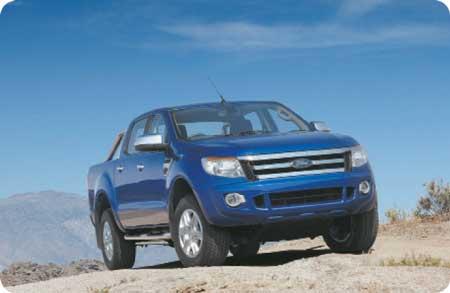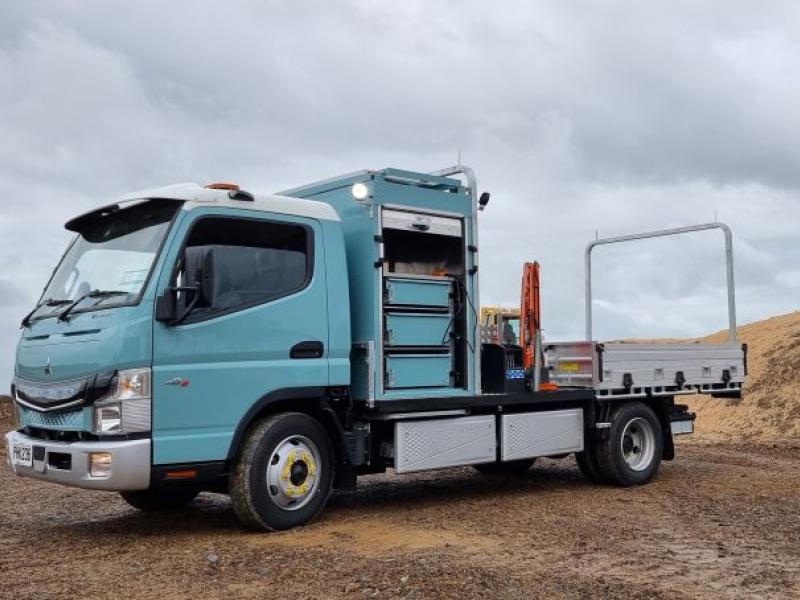| The light commercial segment is a great indicator of the way the economy is performing. And if new model growth is anything to go by, we’re doing all right! John Oxley reports. It has been said that 2012 is going to be the Year of the Ute, and judging by sales in the commercial sector so far this year, mainly led by LCVs, things are improving enormously, commercial sales running 16.3 percent (2,024 vehicles) up on 2010, which in turn was much better than 2009. Latest (August) sales figures show the Toyota Hilux continues to be the top selling model followed by the Nissan Navara, with the Ford Ranger in third, just pipping the Mercedes-Benz Sprinter. But will that all change for next year? Toyota certainly doesn’t think so, with sales and marketing boss Steve Prangnell confident the new facelifted Hilux (see story p6) will be able to hold its own despite the changes being largely cosmetic. He and his team have put a plan together which they are confident will keep the Hilux in front until a completely new model hits the market in 2013. But it’s going to be a big challenge, with new models coming in from all sides, and in all price brackets, ready and willing to topple the Hilux from its perch. First in the starting blocks was the Volkswagen Amarok, introduced halfway through this year as a completely new vehicle from the world’s third-biggest vehicle manufacturer. And it’s an important model for VW, for the German group hasn’t had a ute in its line-up since a limited production Golf Mk1 based front-drive pickup sold in some South American and African markets in the ‘70s and ‘80s. And VW is putting a lot behind the Amarok, with a dedicated plant in Argentina to produce it for global markets, concentrating on all the key ute users such as Australia, New Zealand, Russia and South Africa. The first Amarok to roll off the production line was a 4x4 Double Cab fitted with a 2-litre TDI turbo-diesel producing 120kW/400Nm, enough to keep up with or sometimes exceed the current opposition. However this has until now only been available with a 6-speed manual gearbox, which has limited its takeup in a country which is turning more and more towards automatic transmission as the first choice. But latest news is that an auto shifter will be included in the lineup from the second quarter of next year – and it’s a normal torque-converter ‘box, not a CVT or double clutch unit – and this is sure to lift the Amarok’s appeal ratings, especially since it’s a modern 6-speed. Also new is that a two-wheel drive double cab has just been added, in two power ratings (90kW and 120kW) and two rates of trim, the lower-powered version being aimed at the basic workhorse market – though it still comes well kitted-out. And as we reported in the August issue of Company Vehicle single cab versions are also on their way, in both 2WD and 4WD, and with either of the two TDI engines. A petrol engine is available in some markets, but it’s unlikely to come here. Expect the single cabs about the same time as the auto versions. A big gun in the Amarok’s arsenal is the vehicle’s size – it’s currently the largest ute on the NZ new vehicle market. However VW won’t be the only chaser. As shown by the figures above, Ford is pretty serious about its utes, and next week (as I write) I’m off to Aussie to see the latest fruits of the Ford loins, a brand-new Ranger. Of course it won’t be a complete surprise, with lots of pre-release hype about the vehicle as Ford builds-up to the launch - indicative of how important it is to the sales gurus - but I personally can’t wait to see how much of the hyperbole translates into rolling sheet metal. My guess is plenty, for Ford’s global engineering policy ensures the best minds are applied to every engineering job, no matter where the actual work is being done. In the case of the Ranger the base was Australia, and most of the development work was done there - which should ensure it suits us, too. The new Ranger is bigger than the current model as it aims to outgun not just Hilux, but Amarok too, and in one area at least it’s got all the right ammo, with no fewer than three engines - a 2-litre petrol, and 2.2-litre and 3.2-litre Durotorq turbo-diesels producing 110 kW/375 Nm and 147kW/470Nm respectively, the latter a 5-cylinder diesel, making it the most powerful in its segment - for a while. If current wisdom is followed only the diesels will be offered in New Zealand. No details of the model line-up for New Zealand have been released yet, save that there will be double cab and extended cab versions, and likely single cabs and chassis/cab offerings. Among the most high-tech in its segment, the Ranger replaces two previous-generation compact truck platforms and boasts segment-leading technologies and features, including a new rear view camera system, rear park assist, trailer sway control and adaptive load control. Exceptional towing capability and a payload capacity of up to 1,500 kg on selected models throws down the gauntlet for the opposition. The Ranger was developed with input from Mazda, and the Japanese company will be producing a new BT-50 based on the same underpinnings, using the same engines, and like the Ranger, built in Thailand for the NZ market. However Mazda’s marketing philosophy is likely to be aimed more towards lifestyle than workhorse, and certainly judging from the styling of pre-production models that have been displayed, this could very well be the case. Interiors, too, are expected to be very carlike. This was indicated by a pre-production version of the BT-50 Freestyle Cab shown at the Melbourne Motor Show earlier this year, and which uses the same “suicide door” concept as current BT-50 versions to offer a combination of seating for four, a wide pillar-less door opening, and a large carrying capacity. On each side of the cabin a front-hinged door and a rear hinged panel both open to provide a 1,408 mm-wide opening that makes for easy entry to and exit from either the front or rear seats. Rear-seat comfort has been improved, too, with longer cushions with better thigh support and stable fitment of child seats while the seatback height has been increased by 128 mm. The new Mazda BT-50 will be launched in New Zealand from November this year. Like the Ranger the BT-50 will also be built in Thailand. Another manufacturer intent on upsizing is Holden, which showed a completely new Colorado in Melbourne. As with the Ford a lot of the development work for this vehicle has been done in Australia, although the basic design purportedly came out of Brazil. The vehicles, which are larger than the current Isuzu-based Colorados, will also be built in Thailand and the top-of-the line model will get a 2.8-litre turbo diesel engine, which will probably be the only engine available here in 4WD form if the new model follows current trends. At this stage no details about the power plant are available, but it is likely it will one designed by Italy’s VM Motori, in which Holden’s holding company General Motors has a half share, Fiat owning the other half. VM Motori currently makes a 2.8-litre four-cylinder Euro 5 compliant turbo-diesel which powers the Jeep Wrangler and Cherokee, and produces 147 kW/460 Nm. Suspension is similar to the current Colorado’s, with torsion bars up front and a leaf sprung rear, and dimensions are length 5,339 mm; width 1,901 mm; height 1,789 mm, wheelbase 3,096 mm. Expect the new Colorado in the first quarter of next year. Isuzu is keeping playing its cards very close to its chest as far as the current D-Max replacement is concerned, but we’ve seen spy pictures which indicate the ute, coded RT-50, will be much more rounded than the current model, and with a more sloping windscreen. We do know that both double cab and extended cab versions will be available, and of course, although the two companies don’t seem to like each other very much anymore, there IS still a chassis collaboration agreement in place between Isuzu and Holden/General Motors. That said, the pictures we’ve seen seem to indicate that the next Isuzu will be closer in size to the current mode. No launch date has been released, but expect it in the first half of the year. But wait, that’s not all! |
For some time now SsangYong has been showing a concept version of its next ute, the SUT-1, and this is now set to become reality as the next SsangYong Actyon Sport. |






